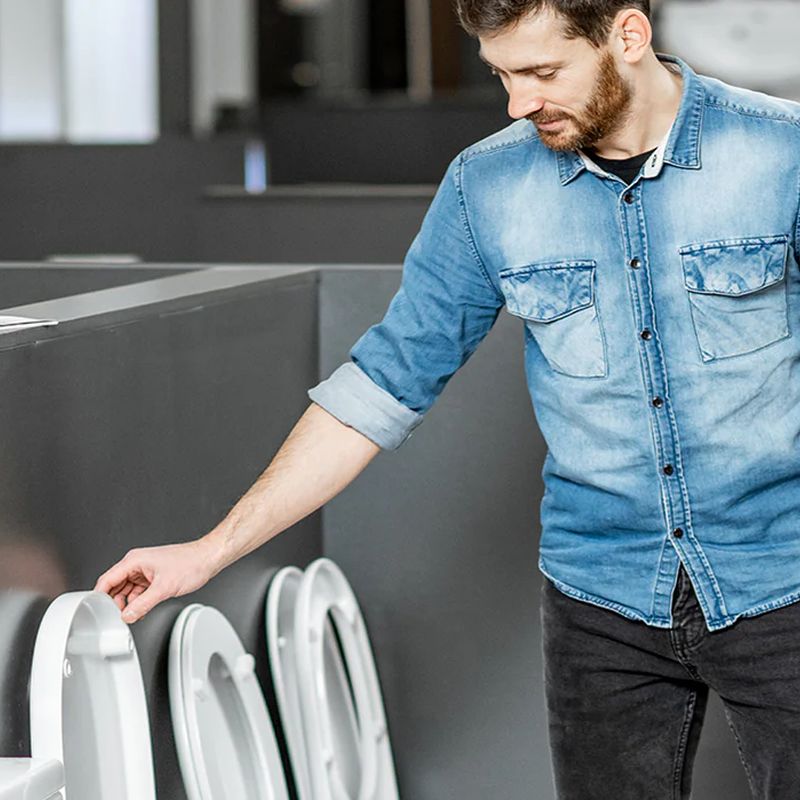 English
English
Jabra Sanitary is a sanitaryware supplier offering toilets, sinks, faucets, bathtubs, etc., at competitive prices. If you're a distributor, wholesaler, or project contractor, get a quote today!
 $23.9 Limited-time Offer
$23.9 Limited-time Offer Consignment Policy
Consignment Policy 20 Years of Experience
20 Years of Experience
Stainless steel sinks are a popular choice for many households due to their sleek appearance, durability, and easy-to-clean surface. However, how to clean stainless steel sink stains is an issue despite their resistance to stains and scratches.
If you've noticed your once-glossy stainless steel sink losing its shine, you're not alone. These sinks can accumulate stains from food, soap scum, hard water deposits, and other common kitchen messes.
In this guide, we will walk you through what to use to clean stainless steel sinks and how to make a stainless steel sink shiny from tackling everyday grime to addressing tougher marks.

Table of Contents
Tools and Materials Required
8 Easy Steps to Clean Stainless Steel Sink Stains
How to Remove Tough Stains or Rust from a Stainless Steel Sink
How Often Should You Clean a Stainless Steel Sink
6 Types of Stainless Steel Finishes and Maintenance Tips
Prevent Damage to Your Stainless Steel Sink: Do's & Don'ts
Why Clean Your Stainless Steel Sink?
FAQs
Our Conclusion
Tools and Materials Required
Before you begin to clean stains from stainless steel sinks, it's important to gather the right tools and materials. Using the correct equipment ensures a more effective cleaning process and helps protect the finish of your sink from scratches or damage.
Here is what to use to clean stainless steel sinks:
Tools
Cleaning Cloth
A microfiber cleaning cloth is ideal for drying your sink after cleaning. Microfiber is gentle on surfaces, reduces the risk of scratching, and can absorb moisture effectively.
Avoid using abrasive cloths like rough towels or paper towels, as they may leave behind lint or cause scratches.
Soft Sponge
When scrubbing away stains, it's crucial to use a soft sponge. A sponge with a soft and non-abrasive side will allow you to clean stains without causing damage.
Harsh scrubbing pads or steel wool can scratch the surface of the stainless steel.
Spray Bottle
A spray bottle is essential for applying cleaning solutions like vinegar, water, or a mild cleaning mixture. It provides controlled distribution and ensures the product is applied evenly over the surface.
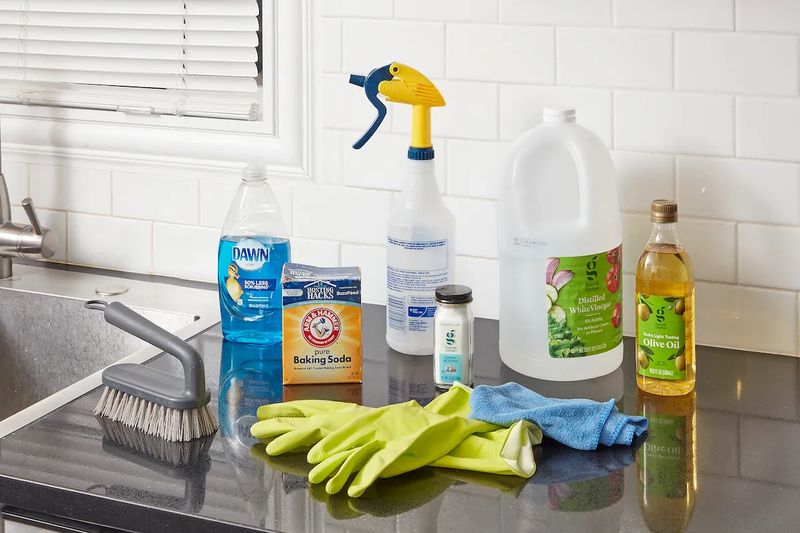
Materials
Baking Soda
Baking soda is a powerful natural cleaner that can be used to remove grease, stains, and even minor rust spots. Cleaning a stainless steel sink with baking soda can lift dirt without scratching the sink's surface.
Dish Soap
Dish soap is a mild yet effective cleaning agent. It's perfect for removing grease and food stains. Using a non-abrasive dish soap will prevent any damage to the finish while ensuring your sink remains clean.
Lemon or Lime
Lemons and limes are natural acids that work wonders on water spots, calcium deposits, and mineral stains. Their acidity helps break down stubborn stains, and they also leave your sink smelling fresh.
You can use the juice directly or rub the rind on stains for a more concentrated effect.
Olive Oil
Olive oil may seem like an unusual choice, but it's great for restoring the shine to your stainless steel sink. After cleaning, a small amount of olive oil applied to a soft cloth can buff out any dullness, leaving your sink gleaming with a smooth and polished finish.
Vinegar
Vinegar is another natural acid that is excellent for cleaning and removing mineral deposits, soap scum, and even rust. It can help dissolve hard water spots and add shine to your sink.
Always dilute vinegar with water to avoid strong odors or potential damage.
Warm Water
Warm water is essential in most cleaning solutions. It helps to loosen dirt and grime from the sink surface, making it easier to clean. It also helps to activate some of the cleaning agents, such as dish soap or baking soda.
8 Easy Steps to Clean Stainless Steel Sink Stains
After gathering the necessary tools and materials, it's time to examine the step-by-step process to clean stains from the stainless steel sink and make it shiny again.
Follow these steps below carefully:
1. Empty Your Sink
Before you begin to clean stains from stainless steel sinks, ensure that your sink is empty of dishes, food scraps, and any other debris. You want a clear workspace to effectively clean every corner of the sink.
A clutter-free sink will also allow cleaning solutions to work more effectively on the stainless steel surface. <Learn different kitchen sink materials>
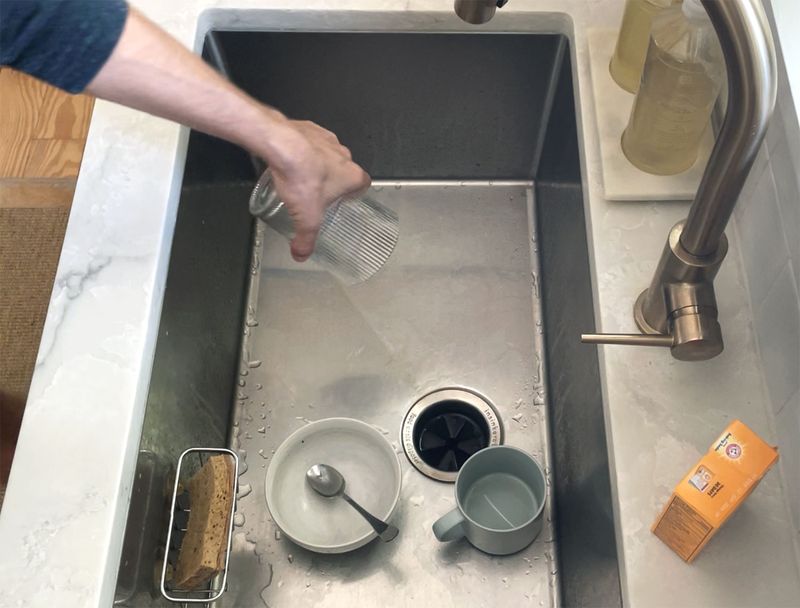
2. Sprinkle with Baking Soda
Sprinkle a generous amount of baking soda all over the surface of the sink. Baking soda is mildly abrasive, which helps to scrub away grime and stains without damaging the stainless steel.
Focus on areas with visible stains or discoloration, but cover the entire surface for an even clean.

3. Add Some Dish Soap
Add a few drops of dish soap to the sink. The dish soap helps to break down grease, oil, and food residues that may be stuck to the sink. Mix the soap with the baking soda by gently spreading it across the surface using your hands or a soft sponge.
You should start to see a slight foaming action as the soap and baking soda begin to react.
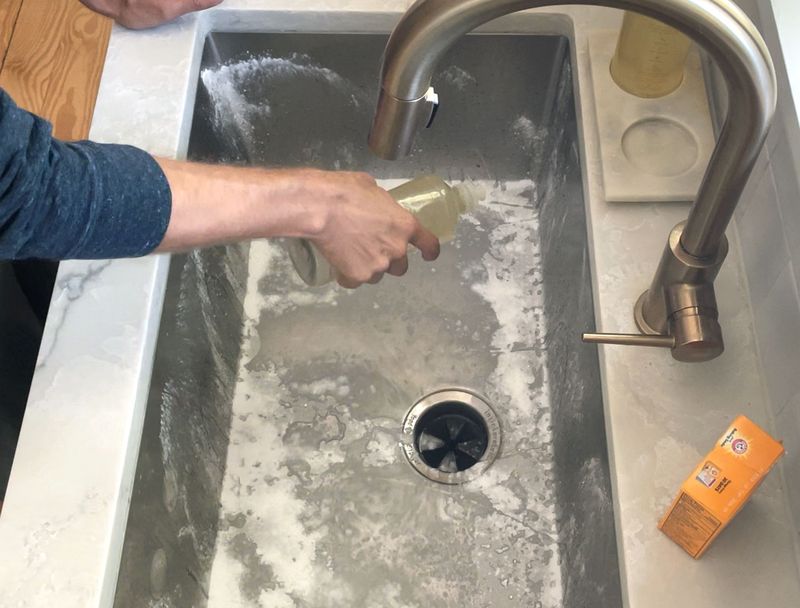
4. Scrub the Sink
Using a soft sponge or a microfiber cloth, begin scrubbing the sink in small circular motions. This technique allows you to gently lift away dirt, food stains, and grease without scratching the sink.
Focus on areas with more stubborn stains, such as the drain, around the faucet, or the bottom of the sink. Apply a bit more pressure if needed, but always be gentle to protect the finish of your sink.
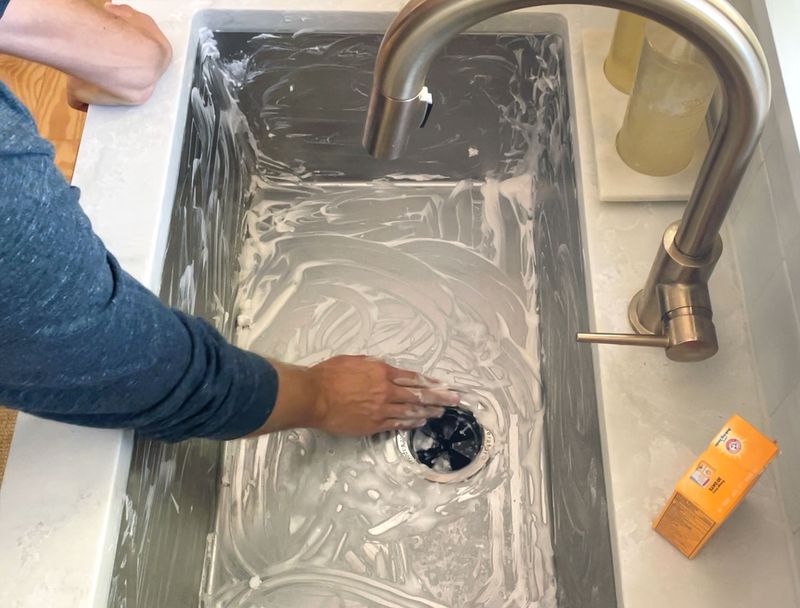
5. Use the Lemon Halves to Scrub Again
After scrubbing with the baking soda and dish soap, take the halves of a lemon and rub them directly onto the stained areas. The natural acidity in lemons helps to break down mineral deposits, water spots, and any remaining stains.
The rough texture of the lemon rind also acts as a natural scrubber to tackle tougher grime.
6. Spray the Sink with a Bottle of Vinegar
Fill a spray bottle with water and vinegar and spray the entire sink surface. Vinegar helps to dissolve hard water deposits, soap scum, and mineral stains that might be lingering.
The vinegar will also help to lift any remaining residue left behind by the baking soda and dish soap. Allow the vinegar solution to sit for a few minutes for maximum effect.
7. Rinse the Sink
After allowing the vinegar to sit, rinse the sink thoroughly with warm water. Make sure to remove all traces of the cleaning agents, lemon juice, and vinegar. It's important to rinse the sink well to avoid any streaks or residue that might dull the surface.

8. Dry and Shine with Olive Oil
Dry the sink with a soft and clean microfiber cloth. Once the sink is dry, apply a small amount of olive oil to a cloth and buff the surface in a circular motion.
Olive oil not only adds a natural shine to the stainless steel but helps protect the surface from future stains and water spots.
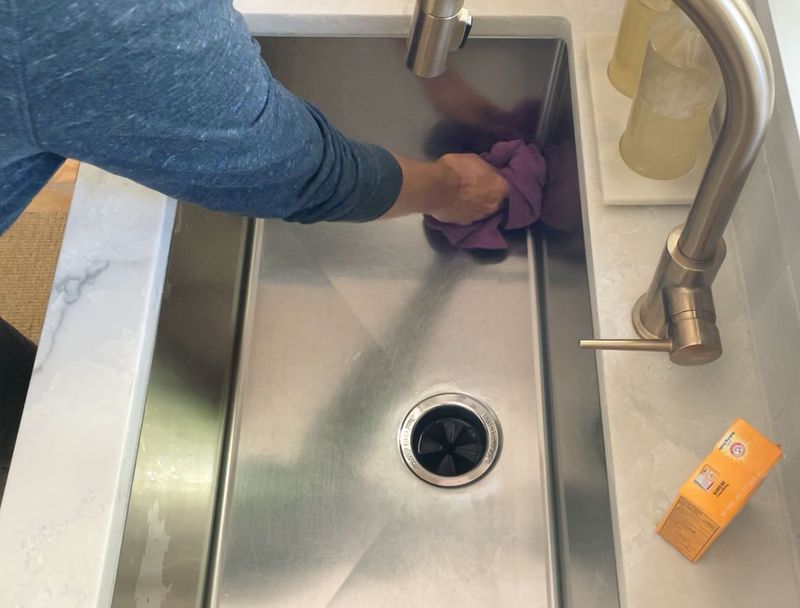
How to Remove Tough Stains or Rust from a Stainless Steel Sink
Sometimes, regular cleaning isn't enough to remove tough stains or rust from your stainless steel sink. Luckily, there are simple ways of removing rust from stainless steel sinks.
Here are some easy steps to follow:
1. Use a Baking Soda Paste for Tough Stains
Baking soda is mixed with water to form a paste that works on tough stains. Apply the paste to the stained area and let it sit for 15-20 minutes.
After it sits, scrub the spot gently with a soft sponge or cloth. This tells you how to clean stainless steel sinks without scratching.
2. Use Vinegar and Baking Soda for Rust
Rust can form on your sink if it's exposed to moisture for too long. Here is how to clean rust from stainless steel sinks:
- Sprinkle baking soda on the rust stains.
- Spray white vinegar over the baking soda (it will fizz).
- Let it sit for 15-20 minutes.
- After the fizzing stops, scrub the area gently with a soft sponge. Rinse the area with warm water and dry it with a microfiber cloth.
3. Use a Commercial Stainless Steel Cleaner for Tough Stains
If the stains or rust are stubborn, you might need a commercial cleaner for stainless steel sinks.
Here is what you need to do with a commercial cleaner for stainless steel sinks:
Follow the instructions on the cleaner.
- Use a soft cloth or sponge to clean the affected areas.
- Wipe away any excess cleaner with a clean cloth and rinse the sink with warm water.
4. Try a Lemon and Salt Scrub for Heavy Stains
Lemon and salt are a great combination for tough stains or water spots. Here's how to use them:
- Cut a lemon in half and sprinkle salt on the cut side.
- Rub the salted lemon on the stained or rusted areas in small circles.
- The lemon helps break down stains, while the salt scrubs them away.
- Let it sit for 5-10 minutes, then rinse with warm water. Dry the sink with a microfiber cloth.
5. Polish the Sink with Olive Oil
Once the stains or rust are gone, use olive oil to add shine and protect the surface. Here's how:
- Put a small amount of olive oil on a clean cloth.
- Buff the sink in circular motions to give it a shiny finish.
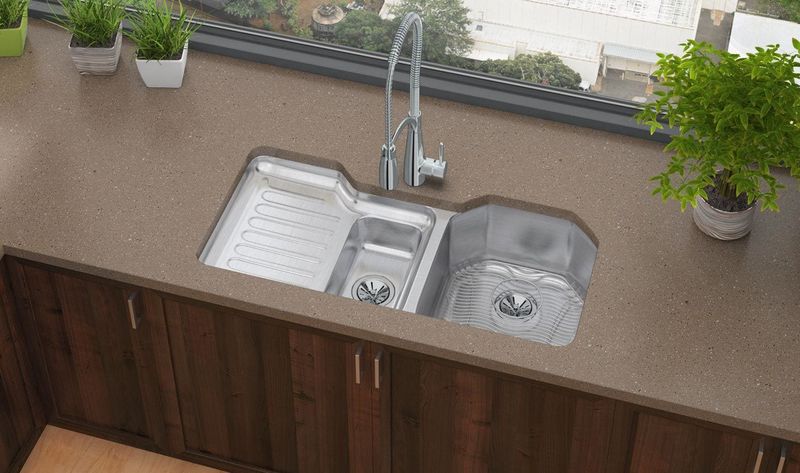
How Often Should You Clean a Stainless Steel Sink
To clean and polish stainless steel sinks regularly helps keep it shiny and free of stains. Different tasks should be done at different times, based on how much the sink is used.
Here's a simple cleaning schedule:
1. Daily: Clean your stainless steel sink
Rinse the sink with warm water.
Wipe it down with dish soap and water.
Dry it with a soft cloth to avoid water spots and streaks.
2. Every 2-3 Days: Use an antibacterial wipe or cleaner
Using an antibacterial wipe or cleaner every two or three days helps kill germs and bacteria, especially around the drain area. Wipe down the sink and faucet to keep it clean and sanitized.
3. Weekly: Do a Deeper Clean
Give your sink a more thorough cleaning to remove soap scum, stains, and any mineral deposits. Here's what to do:
- Sprinkle baking soda on the sink and scrub with a sponge.
- Use vinegar or lemon juice to clean tough stains or water spots.
4. Monthly: Polish to Restore Shine
Polish your sink to restore its shine and protect it from damage. Use a small amount of olive oil or stainless steel polish, apply it to a cloth, and buff the sink in circular motions.
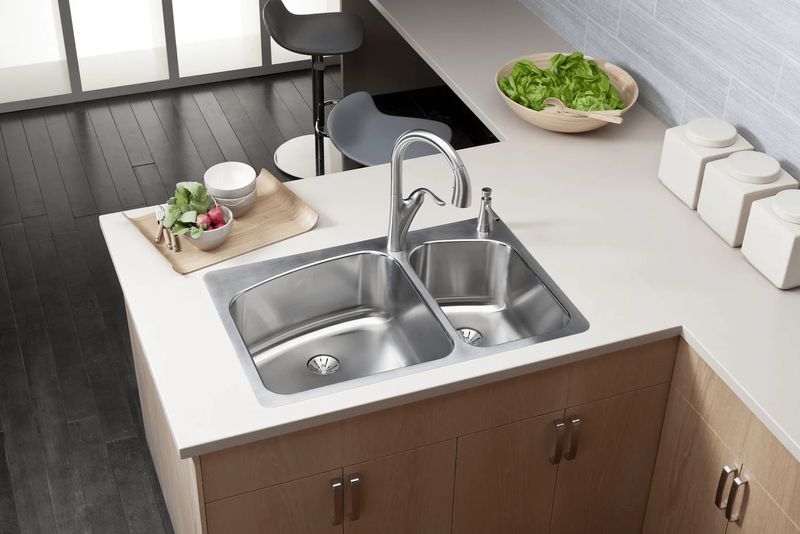
6 Types of Stainless Steel Finishes and Maintenance Tips
Stainless steel sinks come in various finishes, each with distinct characteristics and maintenance needs. Understanding the type of finish on your sink can help you clean and polish stainless steel sinks effectively and preserve their shine.
Here's a look at the most common finishes and their care tips:
1. Brushed Finish
A brushed finish features fine and parallel lines that create a matte appearance. This is one of the most popular finishes for kitchen and bathroom sinks, as it hides fingerprints and water spots well.
To maintain its shine, use a non-abrasive cleaner and a microfiber cloth to wipe it down after each use. For deeper cleaning, you can gently scrub with a soft sponge and a mild dish detergent.
2. Polished Finish
A polished stainless steel finish is glossy and reflective, giving it a high-end and sleek appearance. While it is prone to showing fingerprints and smudges, it is relatively easy to clean.
Regularly wipe the surface with a soft cloth to remove marks, and use a mild stainless steel cleaner or polish to restore its shine. Avoid using harsh chemicals or steel wool, as they can scratch the surface and leave permanent damage.
3. Textured Finish
This finish gives the stainless steel surface a more unique and patterned look with small indentations or a pebble-like texture. Because of its rough surface, a textured finish is less prone to showing fingerprints but can trap dirt and grime in the crevices.
Clean with a soft brush or sponge and a mixture of water and mild soap to reach the small grooves. Dry thoroughly to prevent water spots.
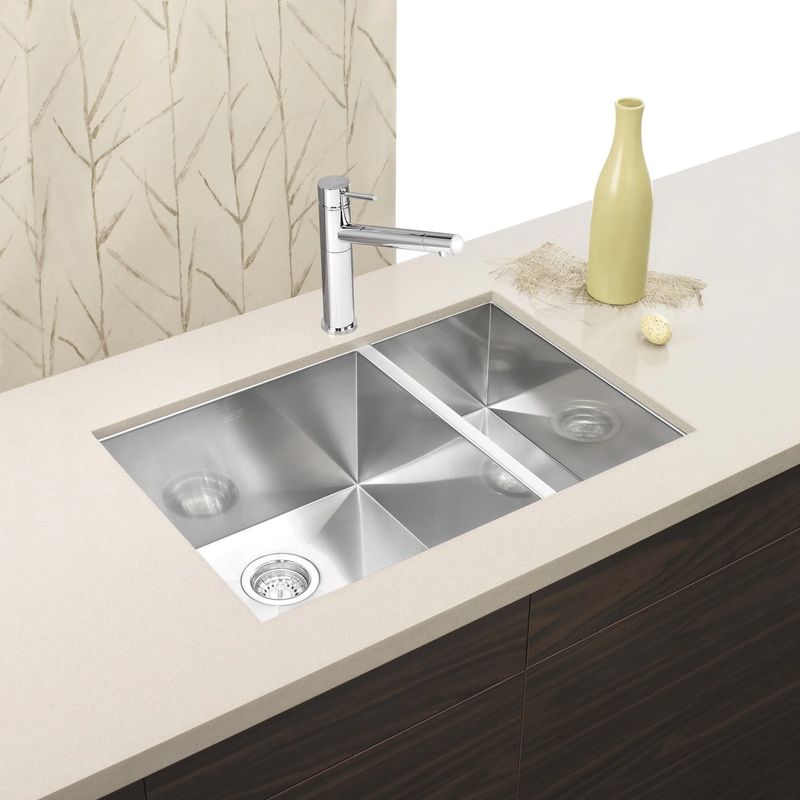
4. PVD Coating (Physical Vapor Deposition)
PVD-coated finishes are a popular choice for modern sinks because of their durable and scratch-resistant properties. This type of coating provides a rich and colored appearance such as black, gold, or bronze.
PVD-coated sinks are low-maintenance and resistant to corrosion.
Simply wipe with a microfiber cloth and mild soap solution, and avoid abrasive cleaners or scrubbing pads.
5. Antique Finish
Antique finishes create a warm and aged look often with darker hues. The finish naturally develops a patina over time, but it can be maintained by gently cleaning it with a soft cloth and a mixture of vinegar and water.
Avoid abrasive cleaners that can strip the finish and alter its character.
6. Diamond Plate Finish
Diamond plate is an industrial-style finish that provides added texture and durability. Its raised pattern helps hide stains and scratches.
Use a soft brush to scrub the surface and remove buildup in the textured areas. Mild dish soap and water work best for regular cleaning but always avoid harsh scrubbing tools.
Prevent Damage to Your Stainless Steel Sink: Do's & Don'ts
To keep your stainless steel sink looking flawless and avoid long-term damage, it's essential to know how to make a stainless steel sink shiny and how to clean stainless steel sink stains including how to clean water stains on stainless steel.
Here are some key do's and don'ts:
Do's
Regular Cleaning: Clean your sink frequently to prevent grime buildup. A quick wipe-down after every use can help maintain its shine and prevent stains from setting in.
Use the Right Cleaner: Always opt for a mild and non-abrasive cleaner designed for stainless steel. Harsh cleaners can strip away the protective layer and cause discoloration.
Follow the Grain: When cleaning or polishing, always wipe in the direction of the grain. This will preserve the finish and prevent scratches.
Dry Thoroughly: After cleaning, make sure to dry the sink with a microfiber cloth. This is how to remove water spots from stainless steel.
Deep Clean Occasionally: Every month or so, do a deeper clean to remove any accumulated mineral deposits or stains that regular cleaning might miss.
Rinse Well: After cleaning, rinse your sink thoroughly to remove any residue that could affect the finish over time.
Polish for Shine: Use a stainless steel polish to restore and enhance the shine of your sink. This is how to make stainless steel sinks look new.
Don'ts
Avoid Harsh Chemicals: Never use bleach, ammonia, or abrasive cleaners, as they can corrode the surface and cause permanent damage.
Avoid Scratching the Sink: Never use steel wool or abrasive sponges that can leave scratches. Always use soft cloths or sponges.
No Rough Scrubbing: Avoid aggressive scrubbing, as it can scratch the finish. Opt for gentle and circular motions instead.
Don't Ignore the Grain: Always clean in line with the grain of the steel. Scrubbing against the grain can cause unwanted scratches.
Avoid Water Stains: Water left to dry on the sink can leave unsightly stains, especially if your water is hard. Dry the sink immediately after use.
Avoid Leaving Water for Extended Periods: Prolonged exposure to water, especially in areas with hard water, can result in rust or mineral deposits. Wipe down the sink regularly.
Don't Neglect Faucet: The faucet area is just as important. Clean and dry it regularly to prevent soap scum, water stains, and mineral buildup.
Avoid Clutter Around the Basin: Avoid piling items around the sink, as this can cause scratches and block water from draining effectively.
Why Clean Your Stainless Steel Sink?
To clean stains from stainless steel sinks is not just about maintaining their shiny appearance—it's essential for hygiene and the longevity of the sink itself.
Here are some key reasons why regular cleaning is important:
1. Reduce Surface Buildup
Over time, food particles, soap scum, and mineral deposits can accumulate on the surface of your stainless steel sink.
Regular cleaning helps to remove these substances before they harden or cause corrosion, preserving the finish and function of your sink.
2. Prevent Stains
Cleaning your sink regularly removes any potential stain-causing substances, such as coffee, grease, or hard water spots. This keeps your sink looking clean and free from unsightly marks.
3. Eliminate Odors
Bacteria and food residue can lead to unpleasant odors in your sink. Regular cleaning helps to eliminate these smells, ensuring your kitchen or bathroom remains fresh.
Pay special attention to drains, as food particles and moisture can quickly cause odors if left unchecked.
4. Rid the Sink of Bacteria and Germs
Routine cleaning removes germs, bacteria, and other harmful microorganisms. This is especially important for kitchens, where the sink is used for food preparation and washing dishes.
FAQs
When it comes to how to clean stainless steel sink stains, some common questions frequently arise. Here are five common questions:
Does bleach ruin stainless steel?
Yes, bleach can damage stainless steel. It can cause discoloration and weaken the protective layer of the material, making it more susceptible to rust and corrosion.
For cleaning, it's best to use a mild cleaner specifically designed for stainless steel.
Does vinegar damage a stainless steel sink?
Vinegar is acidic. While it can be used to clean your sink, it should be used in moderation. Prolonged exposure to vinegar can dull the surface and potentially cause discoloration.
It's best to dilute vinegar with water and rinse the sink thoroughly after use.
How long can I leave vinegar on stainless steel?
You should not leave vinegar on stainless steel for more than 5-10 minutes. Prolonged contact can damage the finish. Always rinse the sink thoroughly after using vinegar to ensure no residue remains.
What will corrode stainless steel?
Substances like chlorine, bleach, and saltwater can corrode stainless steel if left in contact for extended periods. It's important to wipe down your sink regularly and avoid exposure to these corrosive elements.
Does stainless steel rust with water?
While stainless steel is resistant to rust, it is not completely immune. Prolonged exposure to water, especially hard water, can lead to water spots, rust stains, and corrosion over time. Always dry your sink thoroughly after use to prevent these issues.
Our Conclusion
Cleaning and polishing stainless steel sinks is essential for both aesthetic appeal and hygiene. By following the right cleaning, drying, and polishing techniques, using the correct products, and understanding the different finishes, you can ensure your sink remains shiny and free of stains.
When you install a new stainless steel sink, remeber to read this guide before using. If you have any problems with how to clean stainless steel sink stains, please feel free to contact us any time! We are one of the leading kitchen sink brands, dedicated to providing expert advice and high-quality solutions.










